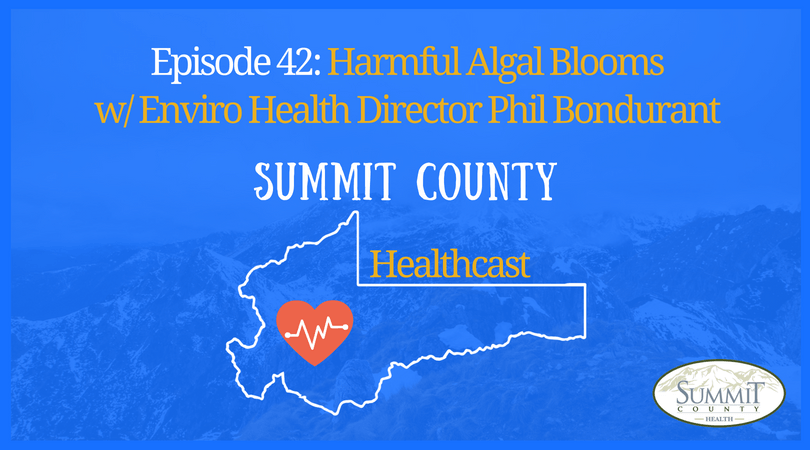Podcast: Play in new window | Download
Subscribe: Apple Podcasts | RSS
Summit County Health Department Environmental Health Director Phil Bondurant returns to the podcast to discuss Harmful Algal Blooms (HABs) and their impact on Summit County lakes and reservoirs. Over the past year (2017-2018), harmful algal blooms have been detected in both Echo and Rockport Reservoirs. Although all of these blooms were small and isolated, there are basic precautions the public should understand and take regarding harmful algae.
For information about current blooms in Utah and further education, please visit habs.utah.gov. Below is a sampling of the information regarding HABs from Utah DEQ:
What are harmful algal blooms (HABs)?
Harmful algal blooms occur when normally occurring cyanobacteria in the water multiply quickly to form visible colonies or blooms. These blooms sometimes produce potent cyanotoxins that pose serious health risks to humans and animals.
Cyanobacteria, also known as blue-green algae, aren’t actually algae, they are prokaryotes, single-celled aquatic organisms that are closely related to bacteria and can photosynthesize like algae. These microorganisms have been a natural part of aquatic ecosystems for thousands of years. Depending upon the species, cyanobacteria can appear as single cells, filaments of cells, or colonies. Their characteristic pigment (“cyan”) gives them their blue-green color, although they can also appear as blue, green, red, or brown in the water.
Although most algal blooms are not toxic, some types of cyanobacteria produce nerve or liver toxins. Toxicity is hard to predict in part because a single species of algae can have both toxic and non-toxic strains, and a bloom that tests nontoxic one day can be toxic the next.
What causes harmful algal blooms (HABs)?
The conditions that lead to harmful algal blooms (HABs) generally occur in the late summer and early fall. These include:
- High nutrient levels, particularly phosphorus
- Abundant sunlight
- Warm water temperatures
- Stagnant or slow-moving waters
If these conditions are present for several days, cyanobacteria can multiply to form large blooms that can cover an entire lake or collect in smaller areas. Blooms generally die and disappear after one or two weeks. However, if conditions remain favorable, overlapping blooms can occur over the course of several months, giving the appearance of one continuous bloom. Algal toxins can linger for days after a bloom has dissipated, and depending on the type of cyanobacteria present, can even increase as toxins are released from dying cells.
How to protect yourself and your family
- Comply with instructions on health advisory signs posted at waterbodies experiencing a harmful algal bloom.
- Stay out of the water and avoid any contact with water or scums if you suspect a waterbody is experiencing a harmful algal bloom.
How to recognize a harmful algal bloom
Harmful algal blooms may look like pea soup, green or blue paint, or have a scum layer or mats/foam floating on the surface. The water may also appear in shades of green, blue-green, yellow, brown, or red.
How to report an exposure
Call the Utah Poison Control Center (UPCC) at (800) 222-1222 if you think you or your pet have been exposed to a harmful algal bloom. UPCC physicians, pharmacists, and nurses trained in toxicology can answer your questions and advise you on the need for further medical or veterinary treatment.
Symptoms of human exposure can include:
- Rashes, hives, or blisters from skin contact
- Runny nose, sore throat, asthma, or allergic-like reactions from breathing in droplets from contaminated water
- Vomiting and diarrhea, stomach pain, weakness, tingling, dizziness, or trouble breathing from swallowing contaminated water
Animals may exhibit the following symptoms:
- Weakness
- Staggering
- Difficulty breathing
- Vomiting
- Convulsions
How to stay safe
Recreation
- Don’t swim in water that has an algal bloom.
- Don’t boat, water ski, or jet-ski on scummy water. These activities can cause toxins to become airborne, increasing the likelihood you will inhale them.
- Don’t let children play with scum in the water or along the shore.
- Don’t let pets or livestock swim in or drink from scummy waters.
- Always take a shower after coming into contact with any surface water whether or not an algal bloom appears to be present. Rinse animals immediately if they swim in scummy water and don’t let them lick their fur.
Water
- Never drink untreated surface water. Untreated surface water may contain bacteria, parasites or viruses, as well as algal toxins, that all could cause illness if ingested.
- Do not boil water in an attempt to remove toxins, as boiling actually releases more toxins.
- Wash dishes with bottled water. Do not use water from areas with algal blooms.
- If your drinking water does not come from a public water system, don’t drink surface water, even if it is treated, during an algal bloom. In-home treatments such as boiling or disinfecting water with chlorine or ultraviolet (UV) or water filtration units do not protect people from harmful algal toxin



Leave A Comment